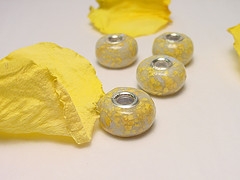
The History Of Gold Jewelry, Part 3
During the 14th and 15th centuries jewelry became an important feature for both male and female attire.
In the first half of the 15th century jewels composed of enameled gold figures, flowers, and foliage modeled in high relief were frequently mixed with clusters of pearls to create stunning ornaments.
The influence of the Spanish court set a standard for the other princely courts of Europe during the 16th Century. At this time the art of engraving on metal was perfected. As trade and communication improved, designers were able to print and distribute their ideas throughout Europe.
The most striking and influential of designs were for figurative pendants of legendary subjects. Later development of this style included a framework of abstract ornament or architectural elements.
The most famous artist-goldsmith of this period was Benvenuto Cellini. He worked in his native Italy and later for Francis I of France. Cellini is known mainly through his autobiography and sculpture. Although, he was renowned as a great goldsmith during his time, no jewelry that he worked on has survived to the present day.
In the 17th century figurative designs became less fashionable and there was a shift of interest to formal designs using faceted gems and pearls. After 1640, the uncut, or cabochon, gem is rarely found in jewelry.
During the 17th century, the Golconda diamond mines opened in India.
Dutch merchants supplied diamonds for the European market and Amsterdam became the center for the trading and cutting of gems and remains so till today.
By the middle of the 17th century a new, many-faceted “rose” style of cutting had replaced old, square “table” cut. Stones were set in close proximity and settings played a smaller part in the overall effect. Silver was frequently used with diamonds to make the setting less visible. Delicate floral designs in enamel were used to decorate the backs of finer jewels.
In the late 17th century Gilles Legare, the court jeweler to Louis XIV of France, was responsible for some of the finest designs. Louis XIV was the last European monarch to wear large numbers of jewels.
18th Century Jewelry
Fashions were lighter and more frivolous in the 18th Century. The sparkle of diamonds seemed brighter as they were cut in the new “brilliant” style that was invented in Venice between the end of the 17th and the beginning of the 18th century. Other innovations included the informal spray of flowers entirely formed of stones. This type of jewelry required the utmost skill of the jeweler.
From 1725 an abundant new source of diamonds in Brazil had a big impact on the development of jewelry. There was also a large demand for imitation, or paste, diamonds.
Paris, the fashion center of the world, was severely disrupted by the French Revolution of 1789 and diamonds became unfashionable during the period of republicanism that followed. Only simple gold jewelry inspired by classical antiquity was worn in the post-revolution period.
Neoclassical designs were well suited to Napoleon I. His wife, Josephine, loved antique cameos and they were made into magnificent “parures.” (Matching sets of jewels consisting of necklace, earrings, and brooches or clasps of various sizes.) Diamonds soon came back into favor in the Napoleonic court and there was a renewed interest in colored stones.
The fashion was for light filigree, or mechanically stamped-out gold jewelry, set with pale-colored semiprecious stones that produced a rich effect at a low cost. This style originated in Britain, where Queen Victoria set the mood for society.
Victorian jewelry, such as lockets and brooches incorporating miniature portraits or locks of hair, was sentimental in feeling and low in intrinsic value. Collection of keepsakes led to an odd fashion of wearing jewelry made of woven human hair.
19th and 20th Century Jewelry
In the nineteenth-century jewelry design was dominated by historical revivals.
The Gothic revival inspired outstanding jewelry and Parisian jewelers again rose to great heights of achievement. In late 1860s diamond settings reached a peak of technical virtuosity with the monture illusion, an elaborate gem-encrusted framework associated with the jeweler Oscar Massin.
During same period, archaeologically correct jewelry originated in Italy, following discoveries of Greek, Roman, and Etruscan gold jewelry.
In 1869 South African diamonds were first brought to Europe and they also helped to supply an enormous market for jewelry among the newly rich in the United States and South America. Large and valuable stones often set in solitaire or as necklaces of single stones, called rivieres, became fashionable. Mechanical technical excellence prevailed and jewelry making became industrialized.
Later prosperity in this century encouraged the growth of large commercial establishments. The most famous of these were Peter Carl Faberge in Saint Petersburg, Russia; and Charles Lewis Tiffany in New York.
During the last half of the 19th century the movement devoted to reforming the applied arts began to affect jewelry as well. This development sprung out of the British Arts and Craft movement. The most progressive jeweler of this epoch was the Frenchman Rene Lalique. His work returned jewelry to the true goldsmith’s tradition and his designs done in the Art Nouveau style compared in brilliance to the works of the Renaissance.
In the 20th century the profession of artist-jeweler becomes established in Scandinavia, where Georg Jensen set a high standard of artistry and craftsmanship with simple, mass-produced jewelry.
Jewelry from the prestigious international houses such as Cartier, Chaumet, Boucheron, Van Cleef and Arpels, and Tiffany continued the conservative tradition of formal gem-set jewelry.
About the Author
Lewis Jewelers is proud to carry the full line of
Pandora Jewelry
. Pandora bracelets, Pandora charms and Pandora beads are only a part of the collection. For more information, Lewis Jewelers, 2000 West Stadium Blvd., Ann Arbor, Michigan, 48103, 877-88-LEWIS or visit the website.
Pandora Style Rose Armband